MKT 4215 - Consumer Perception of Online Reviews Research Report
VerifiedAdded on 2022/11/24
|15
|2965
|333
Report
AI Summary
This research report investigates the perception of consumers towards online reviews and their influence on purchasing behavior within the Malaysian market. The study employs a mixed-methods approach, including surveys and interviews, to analyze the impact of online reviews on consumer choices. The research explores the prevalence of deceptive tactics in online reviews and their effect on consumer purchase intentions. The report formulates hypotheses to examine the relationship between online reviews and buying behavior, as well as the impact of fake reviews. Findings from regression analysis and respondent profiles, including demographics like gender, age, and tenure, are presented to provide a comprehensive understanding of consumer perspectives. The study concludes with recommendations for strategies to mitigate deceptive practices while preserving the authenticity of online reviews, offering valuable insights for e-commerce platforms and marketers.

The perception of the consumers towards online reviews
Market and social research
Market and social research
Paraphrase This Document
Need a fresh take? Get an instant paraphrase of this document with our AI Paraphraser
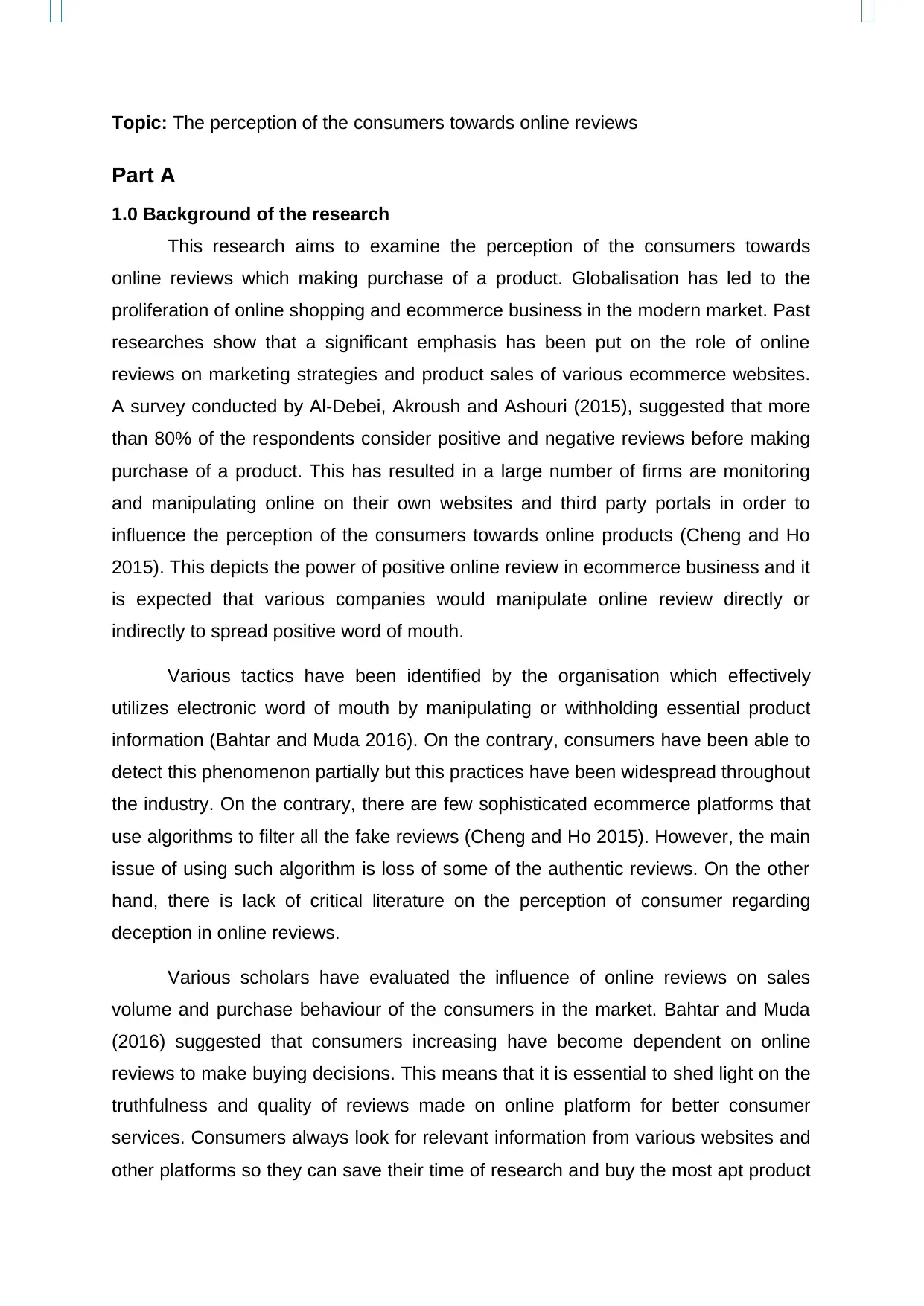
Topic: The perception of the consumers towards online reviews
Part A
1.0 Background of the research
This research aims to examine the perception of the consumers towards
online reviews which making purchase of a product. Globalisation has led to the
proliferation of online shopping and ecommerce business in the modern market. Past
researches show that a significant emphasis has been put on the role of online
reviews on marketing strategies and product sales of various ecommerce websites.
A survey conducted by Al-Debei, Akroush and Ashouri (2015), suggested that more
than 80% of the respondents consider positive and negative reviews before making
purchase of a product. This has resulted in a large number of firms are monitoring
and manipulating online on their own websites and third party portals in order to
influence the perception of the consumers towards online products (Cheng and Ho
2015). This depicts the power of positive online review in ecommerce business and it
is expected that various companies would manipulate online review directly or
indirectly to spread positive word of mouth.
Various tactics have been identified by the organisation which effectively
utilizes electronic word of mouth by manipulating or withholding essential product
information (Bahtar and Muda 2016). On the contrary, consumers have been able to
detect this phenomenon partially but this practices have been widespread throughout
the industry. On the contrary, there are few sophisticated ecommerce platforms that
use algorithms to filter all the fake reviews (Cheng and Ho 2015). However, the main
issue of using such algorithm is loss of some of the authentic reviews. On the other
hand, there is lack of critical literature on the perception of consumer regarding
deception in online reviews.
Various scholars have evaluated the influence of online reviews on sales
volume and purchase behaviour of the consumers in the market. Bahtar and Muda
(2016) suggested that consumers increasing have become dependent on online
reviews to make buying decisions. This means that it is essential to shed light on the
truthfulness and quality of reviews made on online platform for better consumer
services. Consumers always look for relevant information from various websites and
other platforms so they can save their time of research and buy the most apt product
Part A
1.0 Background of the research
This research aims to examine the perception of the consumers towards
online reviews which making purchase of a product. Globalisation has led to the
proliferation of online shopping and ecommerce business in the modern market. Past
researches show that a significant emphasis has been put on the role of online
reviews on marketing strategies and product sales of various ecommerce websites.
A survey conducted by Al-Debei, Akroush and Ashouri (2015), suggested that more
than 80% of the respondents consider positive and negative reviews before making
purchase of a product. This has resulted in a large number of firms are monitoring
and manipulating online on their own websites and third party portals in order to
influence the perception of the consumers towards online products (Cheng and Ho
2015). This depicts the power of positive online review in ecommerce business and it
is expected that various companies would manipulate online review directly or
indirectly to spread positive word of mouth.
Various tactics have been identified by the organisation which effectively
utilizes electronic word of mouth by manipulating or withholding essential product
information (Bahtar and Muda 2016). On the contrary, consumers have been able to
detect this phenomenon partially but this practices have been widespread throughout
the industry. On the contrary, there are few sophisticated ecommerce platforms that
use algorithms to filter all the fake reviews (Cheng and Ho 2015). However, the main
issue of using such algorithm is loss of some of the authentic reviews. On the other
hand, there is lack of critical literature on the perception of consumer regarding
deception in online reviews.
Various scholars have evaluated the influence of online reviews on sales
volume and purchase behaviour of the consumers in the market. Bahtar and Muda
(2016) suggested that consumers increasing have become dependent on online
reviews to make buying decisions. This means that it is essential to shed light on the
truthfulness and quality of reviews made on online platform for better consumer
services. Consumers always look for relevant information from various websites and
other platforms so they can save their time of research and buy the most apt product
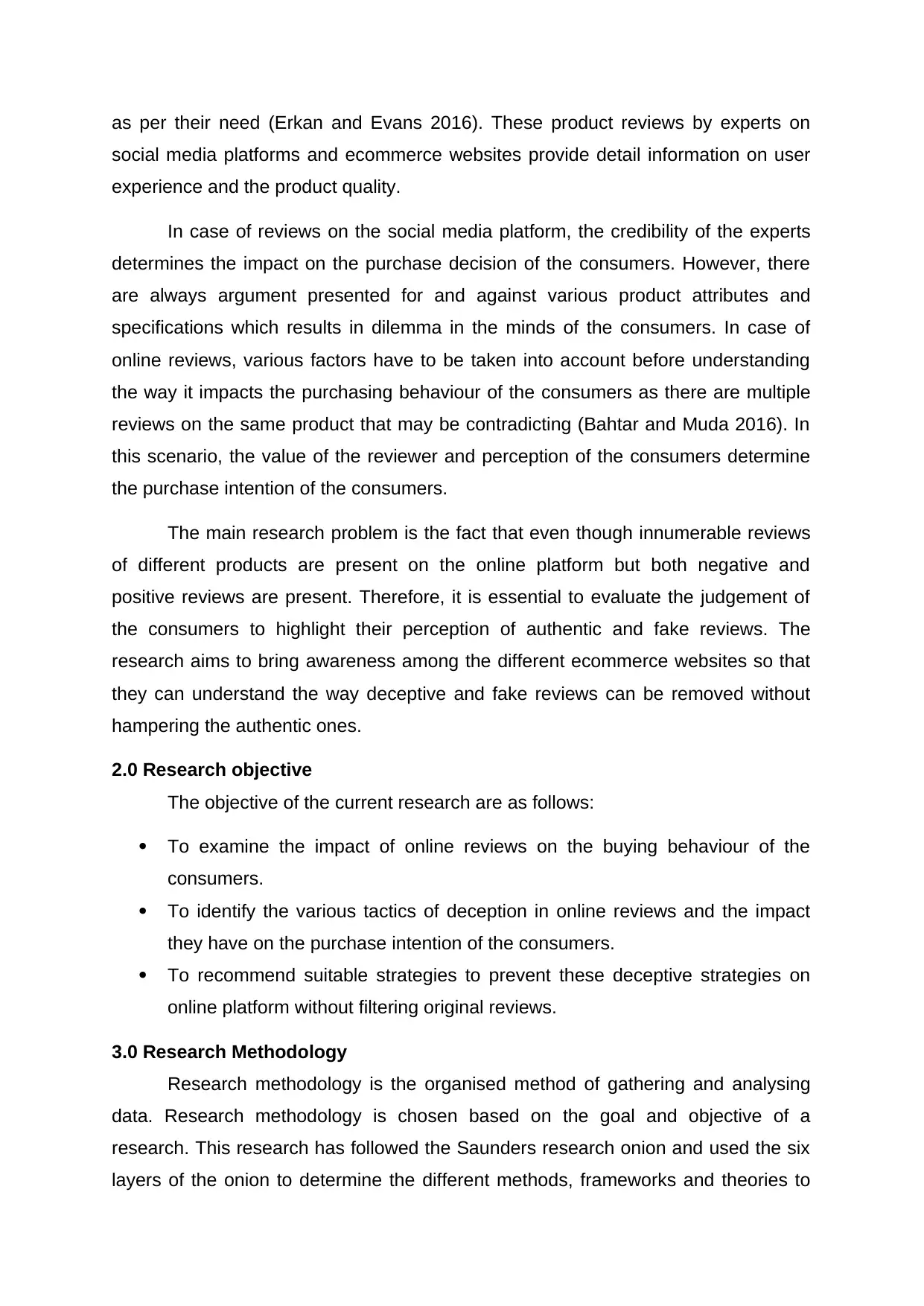
as per their need (Erkan and Evans 2016). These product reviews by experts on
social media platforms and ecommerce websites provide detail information on user
experience and the product quality.
In case of reviews on the social media platform, the credibility of the experts
determines the impact on the purchase decision of the consumers. However, there
are always argument presented for and against various product attributes and
specifications which results in dilemma in the minds of the consumers. In case of
online reviews, various factors have to be taken into account before understanding
the way it impacts the purchasing behaviour of the consumers as there are multiple
reviews on the same product that may be contradicting (Bahtar and Muda 2016). In
this scenario, the value of the reviewer and perception of the consumers determine
the purchase intention of the consumers.
The main research problem is the fact that even though innumerable reviews
of different products are present on the online platform but both negative and
positive reviews are present. Therefore, it is essential to evaluate the judgement of
the consumers to highlight their perception of authentic and fake reviews. The
research aims to bring awareness among the different ecommerce websites so that
they can understand the way deceptive and fake reviews can be removed without
hampering the authentic ones.
2.0 Research objective
The objective of the current research are as follows:
To examine the impact of online reviews on the buying behaviour of the
consumers.
To identify the various tactics of deception in online reviews and the impact
they have on the purchase intention of the consumers.
To recommend suitable strategies to prevent these deceptive strategies on
online platform without filtering original reviews.
3.0 Research Methodology
Research methodology is the organised method of gathering and analysing
data. Research methodology is chosen based on the goal and objective of a
research. This research has followed the Saunders research onion and used the six
layers of the onion to determine the different methods, frameworks and theories to
social media platforms and ecommerce websites provide detail information on user
experience and the product quality.
In case of reviews on the social media platform, the credibility of the experts
determines the impact on the purchase decision of the consumers. However, there
are always argument presented for and against various product attributes and
specifications which results in dilemma in the minds of the consumers. In case of
online reviews, various factors have to be taken into account before understanding
the way it impacts the purchasing behaviour of the consumers as there are multiple
reviews on the same product that may be contradicting (Bahtar and Muda 2016). In
this scenario, the value of the reviewer and perception of the consumers determine
the purchase intention of the consumers.
The main research problem is the fact that even though innumerable reviews
of different products are present on the online platform but both negative and
positive reviews are present. Therefore, it is essential to evaluate the judgement of
the consumers to highlight their perception of authentic and fake reviews. The
research aims to bring awareness among the different ecommerce websites so that
they can understand the way deceptive and fake reviews can be removed without
hampering the authentic ones.
2.0 Research objective
The objective of the current research are as follows:
To examine the impact of online reviews on the buying behaviour of the
consumers.
To identify the various tactics of deception in online reviews and the impact
they have on the purchase intention of the consumers.
To recommend suitable strategies to prevent these deceptive strategies on
online platform without filtering original reviews.
3.0 Research Methodology
Research methodology is the organised method of gathering and analysing
data. Research methodology is chosen based on the goal and objective of a
research. This research has followed the Saunders research onion and used the six
layers of the onion to determine the different methods, frameworks and theories to
⊘ This is a preview!⊘
Do you want full access?
Subscribe today to unlock all pages.

Trusted by 1+ million students worldwide
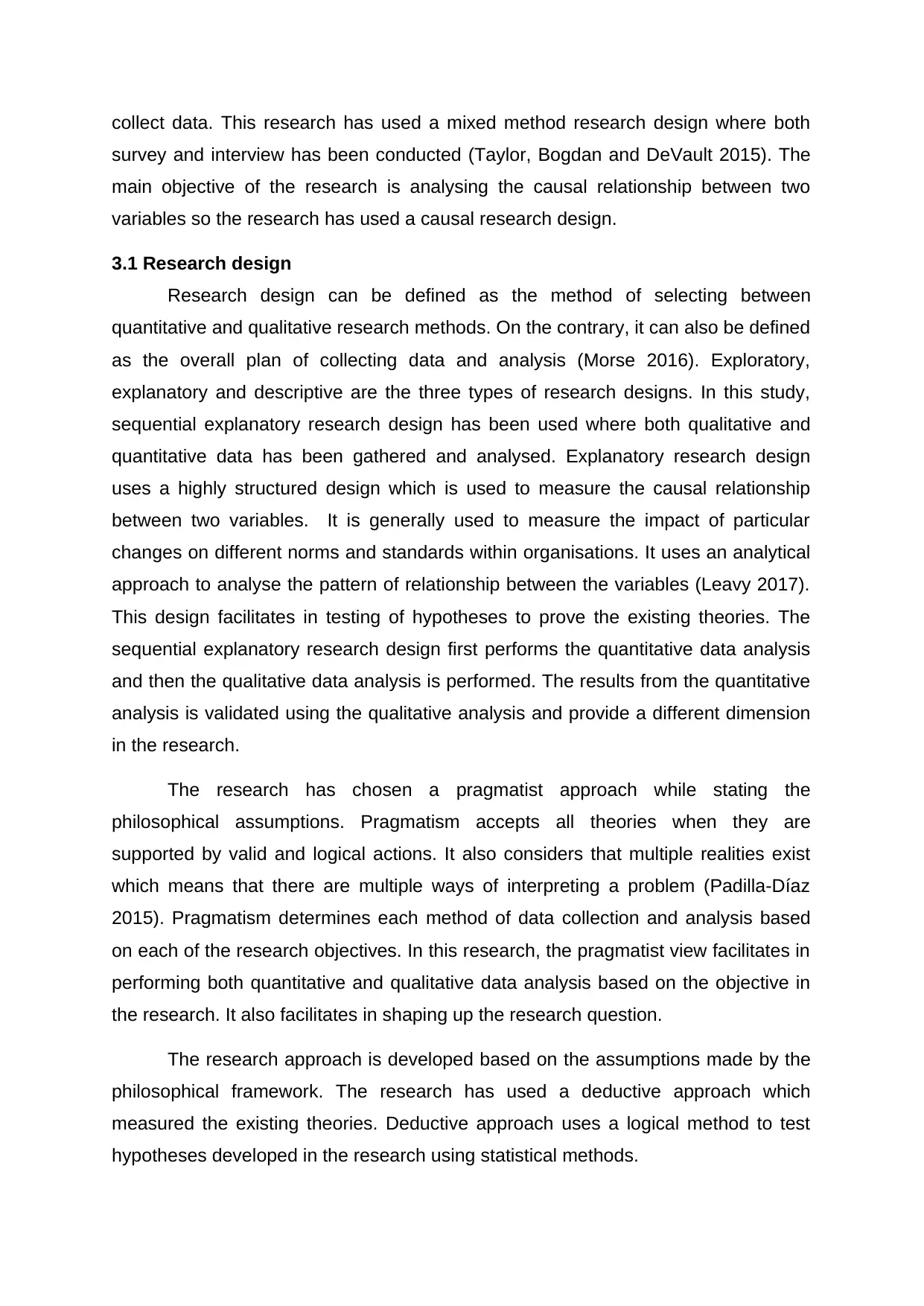
collect data. This research has used a mixed method research design where both
survey and interview has been conducted (Taylor, Bogdan and DeVault 2015). The
main objective of the research is analysing the causal relationship between two
variables so the research has used a causal research design.
3.1 Research design
Research design can be defined as the method of selecting between
quantitative and qualitative research methods. On the contrary, it can also be defined
as the overall plan of collecting data and analysis (Morse 2016). Exploratory,
explanatory and descriptive are the three types of research designs. In this study,
sequential explanatory research design has been used where both qualitative and
quantitative data has been gathered and analysed. Explanatory research design
uses a highly structured design which is used to measure the causal relationship
between two variables. It is generally used to measure the impact of particular
changes on different norms and standards within organisations. It uses an analytical
approach to analyse the pattern of relationship between the variables (Leavy 2017).
This design facilitates in testing of hypotheses to prove the existing theories. The
sequential explanatory research design first performs the quantitative data analysis
and then the qualitative data analysis is performed. The results from the quantitative
analysis is validated using the qualitative analysis and provide a different dimension
in the research.
The research has chosen a pragmatist approach while stating the
philosophical assumptions. Pragmatism accepts all theories when they are
supported by valid and logical actions. It also considers that multiple realities exist
which means that there are multiple ways of interpreting a problem (Padilla-Díaz
2015). Pragmatism determines each method of data collection and analysis based
on each of the research objectives. In this research, the pragmatist view facilitates in
performing both quantitative and qualitative data analysis based on the objective in
the research. It also facilitates in shaping up the research question.
The research approach is developed based on the assumptions made by the
philosophical framework. The research has used a deductive approach which
measured the existing theories. Deductive approach uses a logical method to test
hypotheses developed in the research using statistical methods.
survey and interview has been conducted (Taylor, Bogdan and DeVault 2015). The
main objective of the research is analysing the causal relationship between two
variables so the research has used a causal research design.
3.1 Research design
Research design can be defined as the method of selecting between
quantitative and qualitative research methods. On the contrary, it can also be defined
as the overall plan of collecting data and analysis (Morse 2016). Exploratory,
explanatory and descriptive are the three types of research designs. In this study,
sequential explanatory research design has been used where both qualitative and
quantitative data has been gathered and analysed. Explanatory research design
uses a highly structured design which is used to measure the causal relationship
between two variables. It is generally used to measure the impact of particular
changes on different norms and standards within organisations. It uses an analytical
approach to analyse the pattern of relationship between the variables (Leavy 2017).
This design facilitates in testing of hypotheses to prove the existing theories. The
sequential explanatory research design first performs the quantitative data analysis
and then the qualitative data analysis is performed. The results from the quantitative
analysis is validated using the qualitative analysis and provide a different dimension
in the research.
The research has chosen a pragmatist approach while stating the
philosophical assumptions. Pragmatism accepts all theories when they are
supported by valid and logical actions. It also considers that multiple realities exist
which means that there are multiple ways of interpreting a problem (Padilla-Díaz
2015). Pragmatism determines each method of data collection and analysis based
on each of the research objectives. In this research, the pragmatist view facilitates in
performing both quantitative and qualitative data analysis based on the objective in
the research. It also facilitates in shaping up the research question.
The research approach is developed based on the assumptions made by the
philosophical framework. The research has used a deductive approach which
measured the existing theories. Deductive approach uses a logical method to test
hypotheses developed in the research using statistical methods.
Paraphrase This Document
Need a fresh take? Get an instant paraphrase of this document with our AI Paraphraser
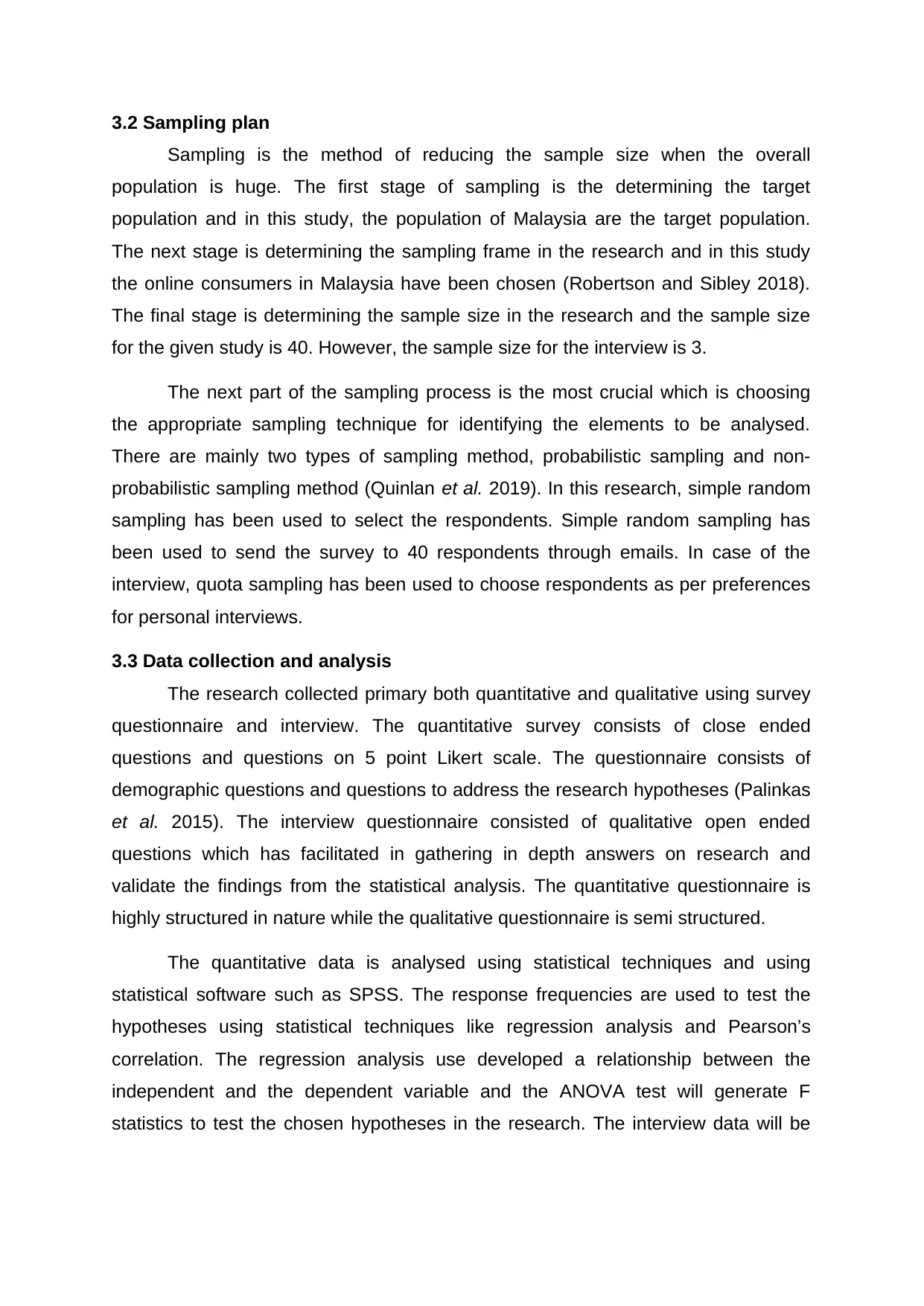
3.2 Sampling plan
Sampling is the method of reducing the sample size when the overall
population is huge. The first stage of sampling is the determining the target
population and in this study, the population of Malaysia are the target population.
The next stage is determining the sampling frame in the research and in this study
the online consumers in Malaysia have been chosen (Robertson and Sibley 2018).
The final stage is determining the sample size in the research and the sample size
for the given study is 40. However, the sample size for the interview is 3.
The next part of the sampling process is the most crucial which is choosing
the appropriate sampling technique for identifying the elements to be analysed.
There are mainly two types of sampling method, probabilistic sampling and non-
probabilistic sampling method (Quinlan et al. 2019). In this research, simple random
sampling has been used to select the respondents. Simple random sampling has
been used to send the survey to 40 respondents through emails. In case of the
interview, quota sampling has been used to choose respondents as per preferences
for personal interviews.
3.3 Data collection and analysis
The research collected primary both quantitative and qualitative using survey
questionnaire and interview. The quantitative survey consists of close ended
questions and questions on 5 point Likert scale. The questionnaire consists of
demographic questions and questions to address the research hypotheses (Palinkas
et al. 2015). The interview questionnaire consisted of qualitative open ended
questions which has facilitated in gathering in depth answers on research and
validate the findings from the statistical analysis. The quantitative questionnaire is
highly structured in nature while the qualitative questionnaire is semi structured.
The quantitative data is analysed using statistical techniques and using
statistical software such as SPSS. The response frequencies are used to test the
hypotheses using statistical techniques like regression analysis and Pearson’s
correlation. The regression analysis use developed a relationship between the
independent and the dependent variable and the ANOVA test will generate F
statistics to test the chosen hypotheses in the research. The interview data will be
Sampling is the method of reducing the sample size when the overall
population is huge. The first stage of sampling is the determining the target
population and in this study, the population of Malaysia are the target population.
The next stage is determining the sampling frame in the research and in this study
the online consumers in Malaysia have been chosen (Robertson and Sibley 2018).
The final stage is determining the sample size in the research and the sample size
for the given study is 40. However, the sample size for the interview is 3.
The next part of the sampling process is the most crucial which is choosing
the appropriate sampling technique for identifying the elements to be analysed.
There are mainly two types of sampling method, probabilistic sampling and non-
probabilistic sampling method (Quinlan et al. 2019). In this research, simple random
sampling has been used to select the respondents. Simple random sampling has
been used to send the survey to 40 respondents through emails. In case of the
interview, quota sampling has been used to choose respondents as per preferences
for personal interviews.
3.3 Data collection and analysis
The research collected primary both quantitative and qualitative using survey
questionnaire and interview. The quantitative survey consists of close ended
questions and questions on 5 point Likert scale. The questionnaire consists of
demographic questions and questions to address the research hypotheses (Palinkas
et al. 2015). The interview questionnaire consisted of qualitative open ended
questions which has facilitated in gathering in depth answers on research and
validate the findings from the statistical analysis. The quantitative questionnaire is
highly structured in nature while the qualitative questionnaire is semi structured.
The quantitative data is analysed using statistical techniques and using
statistical software such as SPSS. The response frequencies are used to test the
hypotheses using statistical techniques like regression analysis and Pearson’s
correlation. The regression analysis use developed a relationship between the
independent and the dependent variable and the ANOVA test will generate F
statistics to test the chosen hypotheses in the research. The interview data will be

analysed using coding where the patterns in the data will be identified to form key
themes and compare with the quantitative data.
Part B
4.0 Hypothesis formulation
Hypothesis 1
H01: There is no significant impact of online reviews on the buying behaviour of the
consumers in Malaysia.
H11: There is significant impact of online reviews on the buying behaviour of the
consumers in Malaysia.
Hypothesis 2
H02: There is no significant impact of fake online reviews on the buying behaviour of
the consumers in Malaysia.
H12: There is significant impact of fake online reviews on the buying behaviour of the
consumers in Malaysia.
5.0 Results
Respondent profile
Gender
Frequency Percent Valid Percent Cumulative Percent
Valid 1 22 55.0 55.0 55.0
2 18 45.0 45.0 100.0
Total 40 100.0 100.0
Age
Frequency Percent Valid Percent Cumulative Percent
Valid 17-24 7 17.5 17.5 17.5
25-30 10 25.0 25.0 42.5
31-35 6 15.0 15.0 57.5
36-40 9 22.5 22.5 80.0
41-49 8 20.0 20.0 100.0
Total 40 100.0 100.0
themes and compare with the quantitative data.
Part B
4.0 Hypothesis formulation
Hypothesis 1
H01: There is no significant impact of online reviews on the buying behaviour of the
consumers in Malaysia.
H11: There is significant impact of online reviews on the buying behaviour of the
consumers in Malaysia.
Hypothesis 2
H02: There is no significant impact of fake online reviews on the buying behaviour of
the consumers in Malaysia.
H12: There is significant impact of fake online reviews on the buying behaviour of the
consumers in Malaysia.
5.0 Results
Respondent profile
Gender
Frequency Percent Valid Percent Cumulative Percent
Valid 1 22 55.0 55.0 55.0
2 18 45.0 45.0 100.0
Total 40 100.0 100.0
Age
Frequency Percent Valid Percent Cumulative Percent
Valid 17-24 7 17.5 17.5 17.5
25-30 10 25.0 25.0 42.5
31-35 6 15.0 15.0 57.5
36-40 9 22.5 22.5 80.0
41-49 8 20.0 20.0 100.0
Total 40 100.0 100.0
⊘ This is a preview!⊘
Do you want full access?
Subscribe today to unlock all pages.

Trusted by 1+ million students worldwide
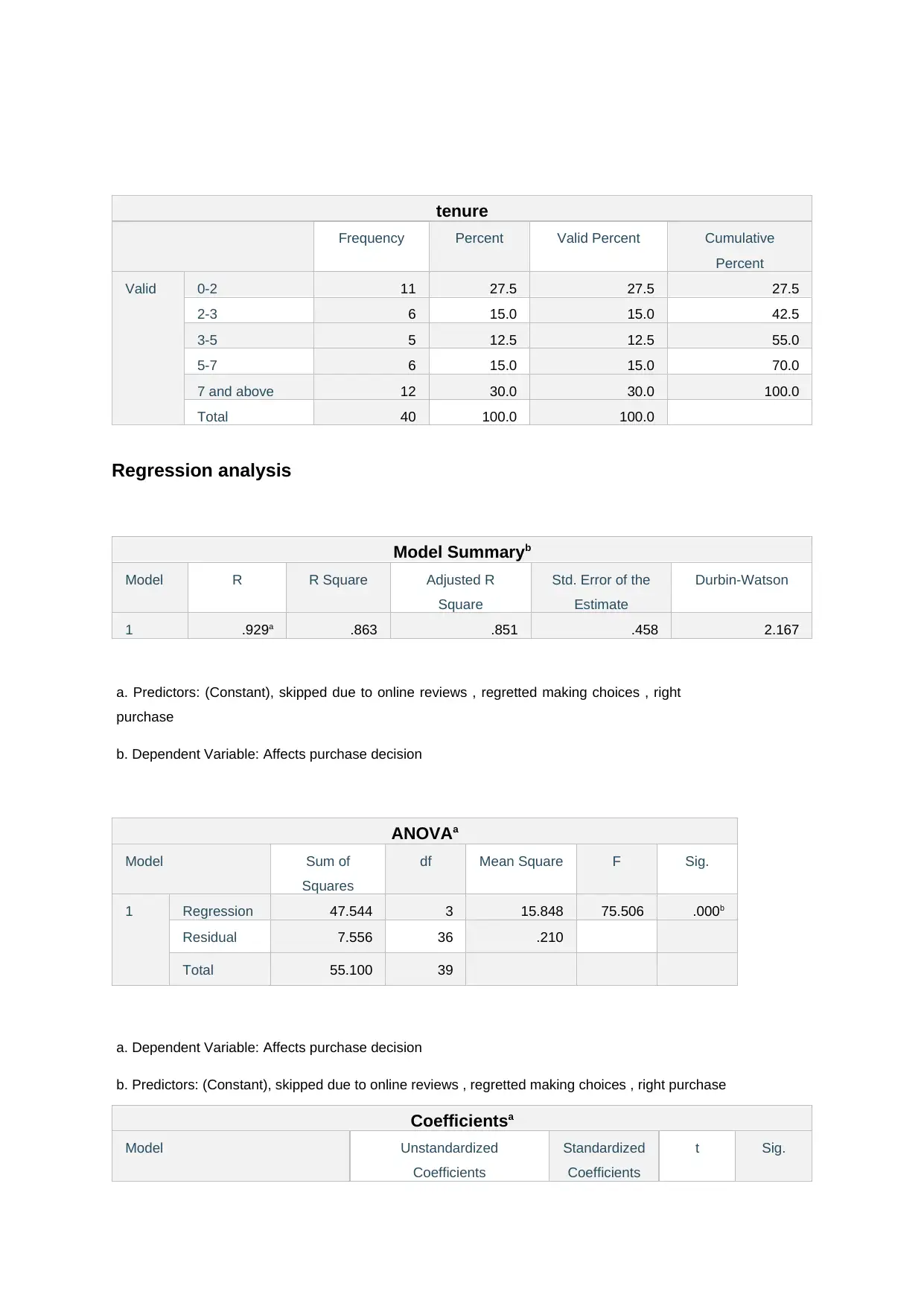
tenure
Frequency Percent Valid Percent Cumulative
Percent
Valid 0-2 11 27.5 27.5 27.5
2-3 6 15.0 15.0 42.5
3-5 5 12.5 12.5 55.0
5-7 6 15.0 15.0 70.0
7 and above 12 30.0 30.0 100.0
Total 40 100.0 100.0
Regression analysis
Model Summaryb
Model R R Square Adjusted R
Square
Std. Error of the
Estimate
Durbin-Watson
1 .929a .863 .851 .458 2.167
a. Predictors: (Constant), skipped due to online reviews , regretted making choices , right
purchase
b. Dependent Variable: Affects purchase decision
ANOVAa
Model Sum of
Squares
df Mean Square F Sig.
1 Regression 47.544 3 15.848 75.506 .000b
Residual 7.556 36 .210
Total 55.100 39
a. Dependent Variable: Affects purchase decision
b. Predictors: (Constant), skipped due to online reviews , regretted making choices , right purchase
Coefficientsa
Model Unstandardized
Coefficients
Standardized
Coefficients
t Sig.
Frequency Percent Valid Percent Cumulative
Percent
Valid 0-2 11 27.5 27.5 27.5
2-3 6 15.0 15.0 42.5
3-5 5 12.5 12.5 55.0
5-7 6 15.0 15.0 70.0
7 and above 12 30.0 30.0 100.0
Total 40 100.0 100.0
Regression analysis
Model Summaryb
Model R R Square Adjusted R
Square
Std. Error of the
Estimate
Durbin-Watson
1 .929a .863 .851 .458 2.167
a. Predictors: (Constant), skipped due to online reviews , regretted making choices , right
purchase
b. Dependent Variable: Affects purchase decision
ANOVAa
Model Sum of
Squares
df Mean Square F Sig.
1 Regression 47.544 3 15.848 75.506 .000b
Residual 7.556 36 .210
Total 55.100 39
a. Dependent Variable: Affects purchase decision
b. Predictors: (Constant), skipped due to online reviews , regretted making choices , right purchase
Coefficientsa
Model Unstandardized
Coefficients
Standardized
Coefficients
t Sig.
Paraphrase This Document
Need a fresh take? Get an instant paraphrase of this document with our AI Paraphraser
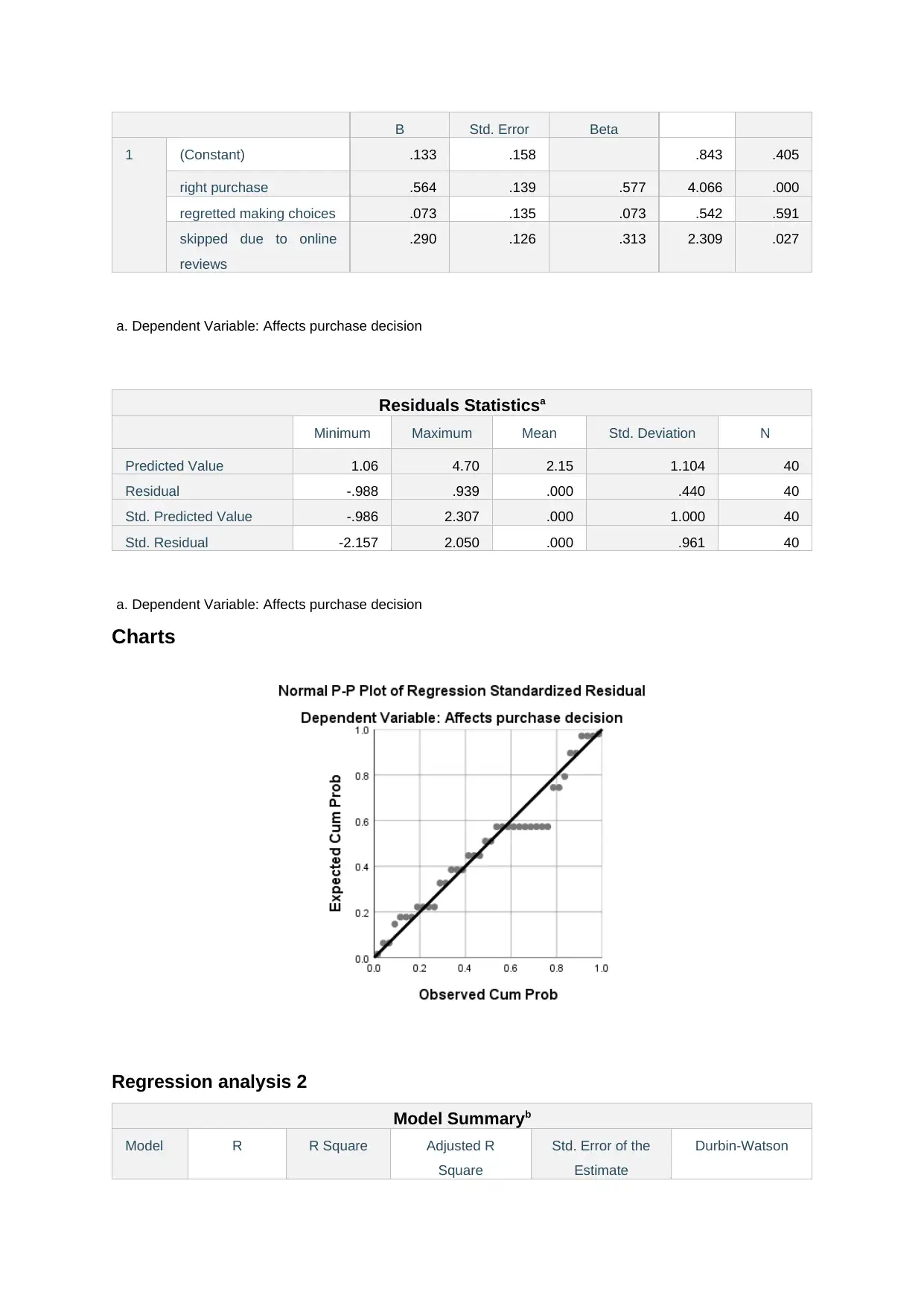
B Std. Error Beta
1 (Constant) .133 .158 .843 .405
right purchase .564 .139 .577 4.066 .000
regretted making choices .073 .135 .073 .542 .591
skipped due to online
reviews
.290 .126 .313 2.309 .027
a. Dependent Variable: Affects purchase decision
Residuals Statisticsa
Minimum Maximum Mean Std. Deviation N
Predicted Value 1.06 4.70 2.15 1.104 40
Residual -.988 .939 .000 .440 40
Std. Predicted Value -.986 2.307 .000 1.000 40
Std. Residual -2.157 2.050 .000 .961 40
a. Dependent Variable: Affects purchase decision
Charts
Regression analysis 2
Model Summaryb
Model R R Square Adjusted R
Square
Std. Error of the
Estimate
Durbin-Watson
1 (Constant) .133 .158 .843 .405
right purchase .564 .139 .577 4.066 .000
regretted making choices .073 .135 .073 .542 .591
skipped due to online
reviews
.290 .126 .313 2.309 .027
a. Dependent Variable: Affects purchase decision
Residuals Statisticsa
Minimum Maximum Mean Std. Deviation N
Predicted Value 1.06 4.70 2.15 1.104 40
Residual -.988 .939 .000 .440 40
Std. Predicted Value -.986 2.307 .000 1.000 40
Std. Residual -2.157 2.050 .000 .961 40
a. Dependent Variable: Affects purchase decision
Charts
Regression analysis 2
Model Summaryb
Model R R Square Adjusted R
Square
Std. Error of the
Estimate
Durbin-Watson
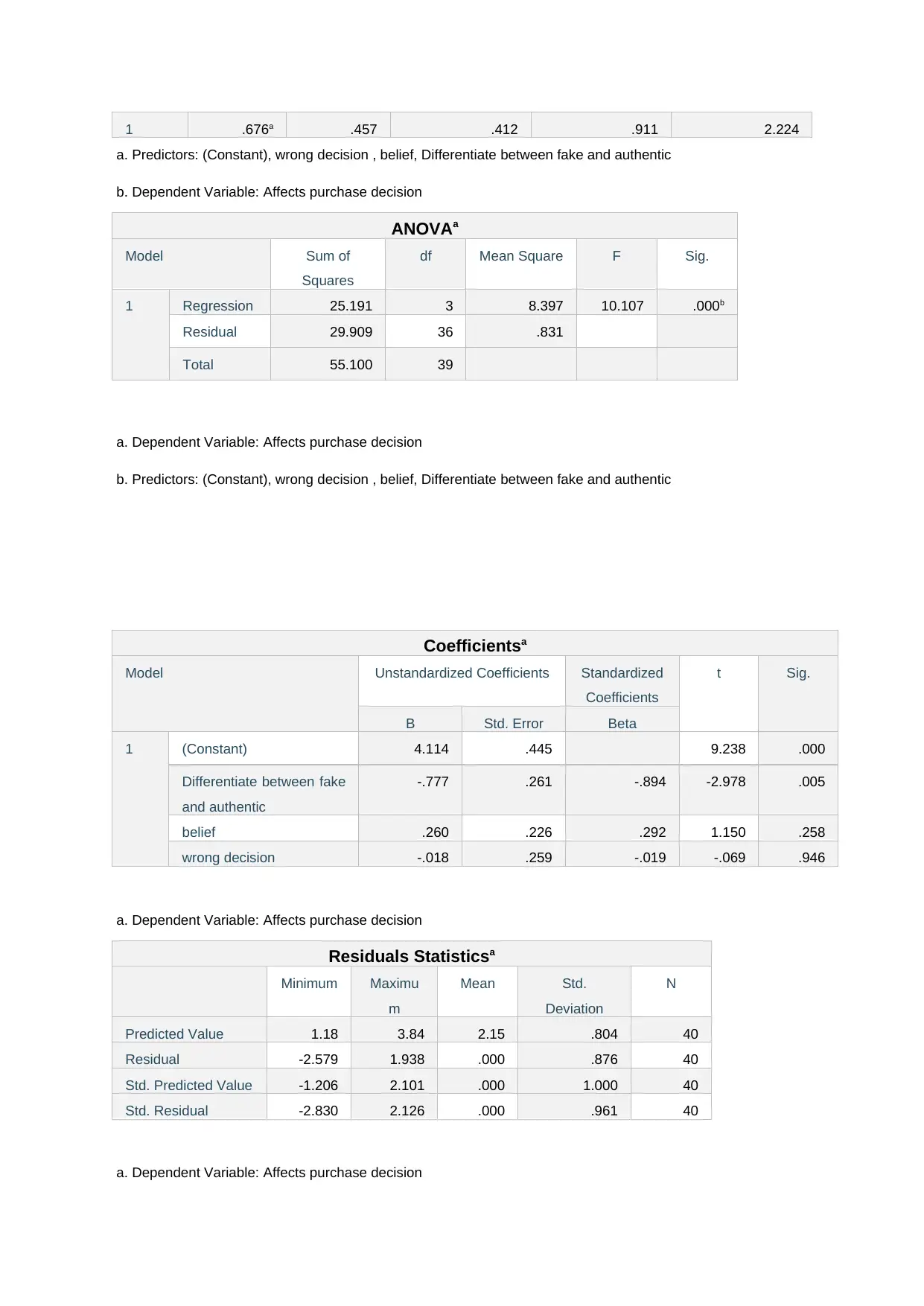
1 .676a .457 .412 .911 2.224
a. Predictors: (Constant), wrong decision , belief, Differentiate between fake and authentic
b. Dependent Variable: Affects purchase decision
ANOVAa
Model Sum of
Squares
df Mean Square F Sig.
1 Regression 25.191 3 8.397 10.107 .000b
Residual 29.909 36 .831
Total 55.100 39
a. Dependent Variable: Affects purchase decision
b. Predictors: (Constant), wrong decision , belief, Differentiate between fake and authentic
Coefficientsa
Model Unstandardized Coefficients Standardized
Coefficients
t Sig.
B Std. Error Beta
1 (Constant) 4.114 .445 9.238 .000
Differentiate between fake
and authentic
-.777 .261 -.894 -2.978 .005
belief .260 .226 .292 1.150 .258
wrong decision -.018 .259 -.019 -.069 .946
a. Dependent Variable: Affects purchase decision
Residuals Statisticsa
Minimum Maximu
m
Mean Std.
Deviation
N
Predicted Value 1.18 3.84 2.15 .804 40
Residual -2.579 1.938 .000 .876 40
Std. Predicted Value -1.206 2.101 .000 1.000 40
Std. Residual -2.830 2.126 .000 .961 40
a. Dependent Variable: Affects purchase decision
a. Predictors: (Constant), wrong decision , belief, Differentiate between fake and authentic
b. Dependent Variable: Affects purchase decision
ANOVAa
Model Sum of
Squares
df Mean Square F Sig.
1 Regression 25.191 3 8.397 10.107 .000b
Residual 29.909 36 .831
Total 55.100 39
a. Dependent Variable: Affects purchase decision
b. Predictors: (Constant), wrong decision , belief, Differentiate between fake and authentic
Coefficientsa
Model Unstandardized Coefficients Standardized
Coefficients
t Sig.
B Std. Error Beta
1 (Constant) 4.114 .445 9.238 .000
Differentiate between fake
and authentic
-.777 .261 -.894 -2.978 .005
belief .260 .226 .292 1.150 .258
wrong decision -.018 .259 -.019 -.069 .946
a. Dependent Variable: Affects purchase decision
Residuals Statisticsa
Minimum Maximu
m
Mean Std.
Deviation
N
Predicted Value 1.18 3.84 2.15 .804 40
Residual -2.579 1.938 .000 .876 40
Std. Predicted Value -1.206 2.101 .000 1.000 40
Std. Residual -2.830 2.126 .000 .961 40
a. Dependent Variable: Affects purchase decision
⊘ This is a preview!⊘
Do you want full access?
Subscribe today to unlock all pages.

Trusted by 1+ million students worldwide
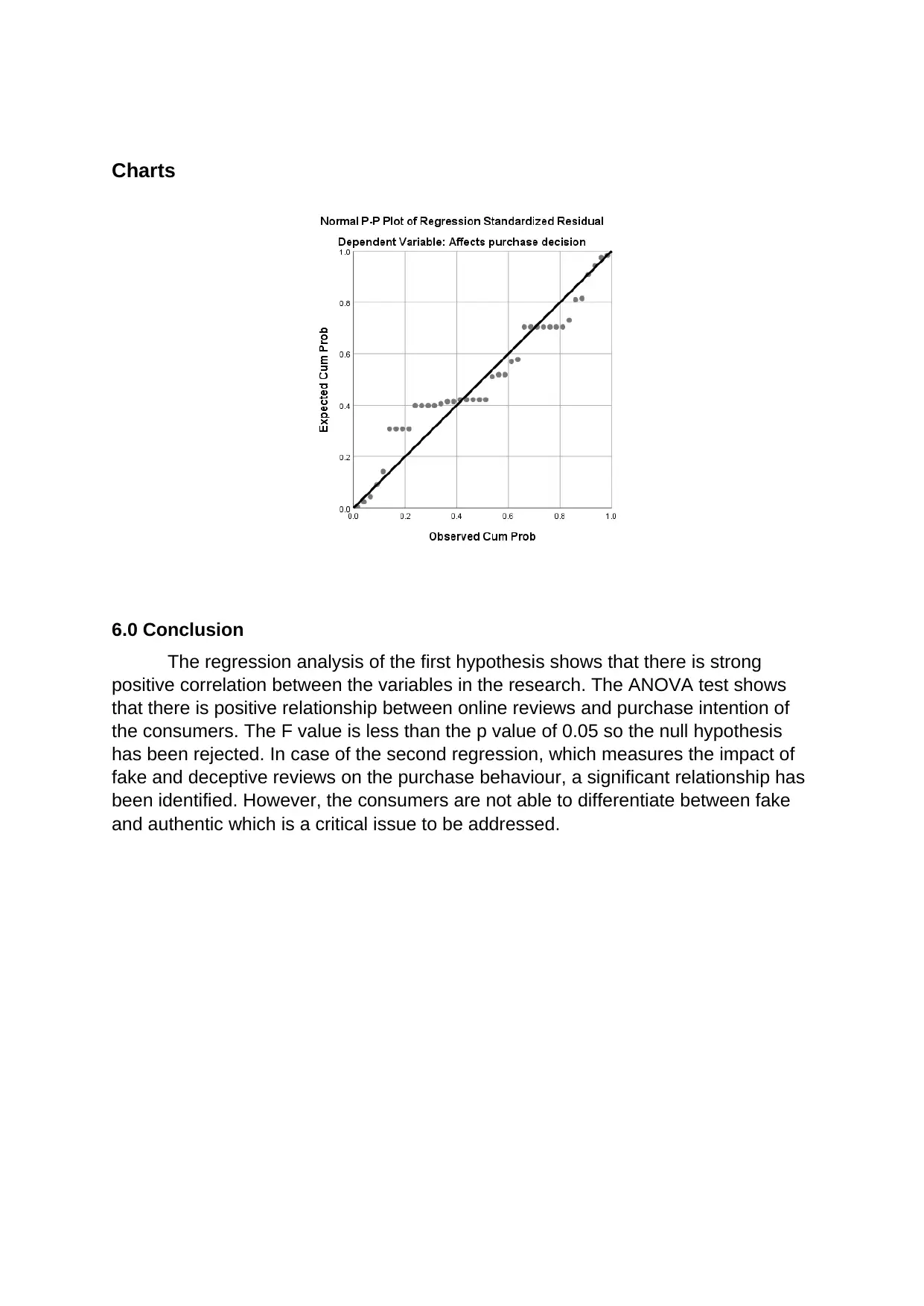
Charts
6.0 Conclusion
The regression analysis of the first hypothesis shows that there is strong
positive correlation between the variables in the research. The ANOVA test shows
that there is positive relationship between online reviews and purchase intention of
the consumers. The F value is less than the p value of 0.05 so the null hypothesis
has been rejected. In case of the second regression, which measures the impact of
fake and deceptive reviews on the purchase behaviour, a significant relationship has
been identified. However, the consumers are not able to differentiate between fake
and authentic which is a critical issue to be addressed.
6.0 Conclusion
The regression analysis of the first hypothesis shows that there is strong
positive correlation between the variables in the research. The ANOVA test shows
that there is positive relationship between online reviews and purchase intention of
the consumers. The F value is less than the p value of 0.05 so the null hypothesis
has been rejected. In case of the second regression, which measures the impact of
fake and deceptive reviews on the purchase behaviour, a significant relationship has
been identified. However, the consumers are not able to differentiate between fake
and authentic which is a critical issue to be addressed.
Paraphrase This Document
Need a fresh take? Get an instant paraphrase of this document with our AI Paraphraser
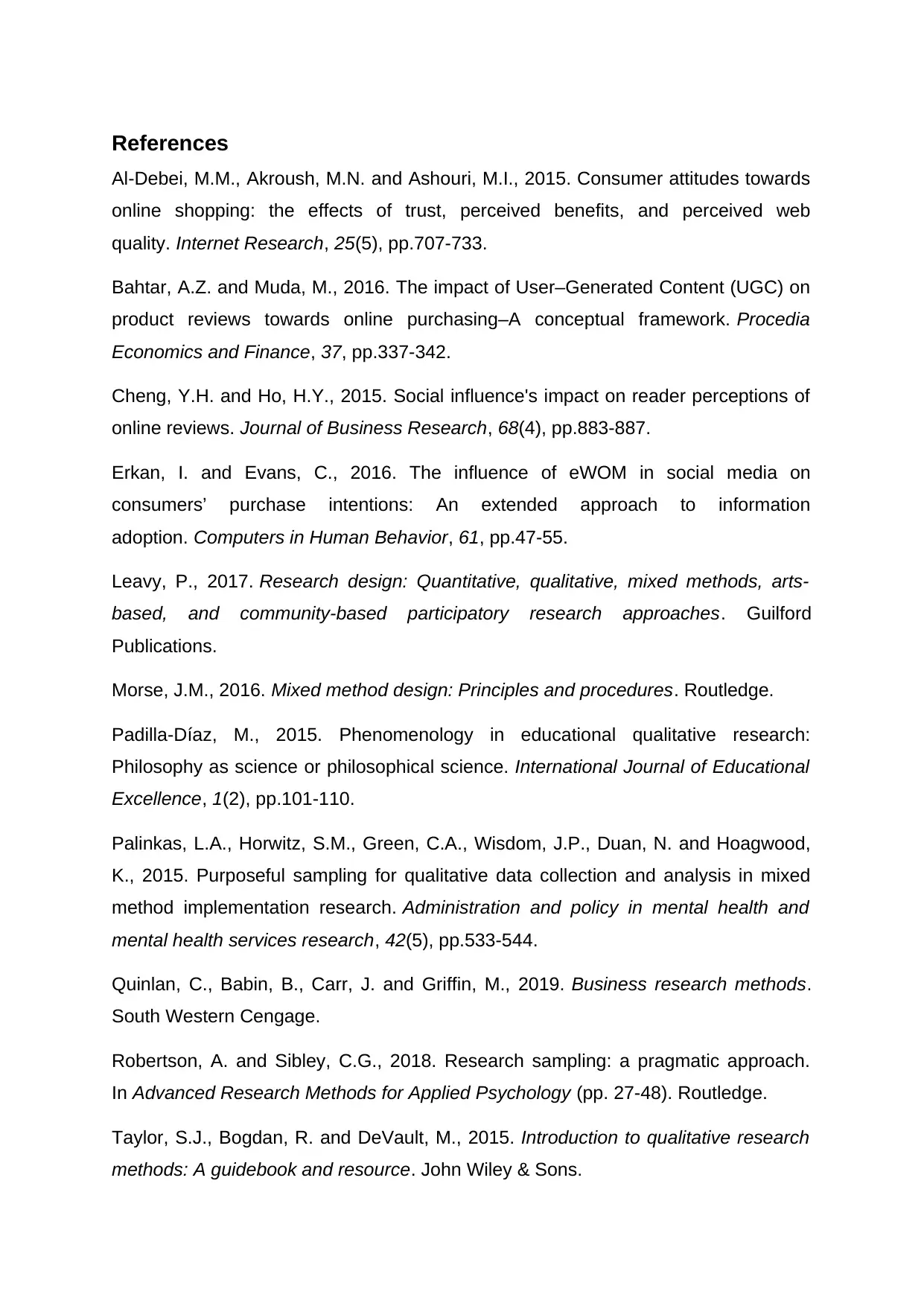
References
Al-Debei, M.M., Akroush, M.N. and Ashouri, M.I., 2015. Consumer attitudes towards
online shopping: the effects of trust, perceived benefits, and perceived web
quality. Internet Research, 25(5), pp.707-733.
Bahtar, A.Z. and Muda, M., 2016. The impact of User–Generated Content (UGC) on
product reviews towards online purchasing–A conceptual framework. Procedia
Economics and Finance, 37, pp.337-342.
Cheng, Y.H. and Ho, H.Y., 2015. Social influence's impact on reader perceptions of
online reviews. Journal of Business Research, 68(4), pp.883-887.
Erkan, I. and Evans, C., 2016. The influence of eWOM in social media on
consumers’ purchase intentions: An extended approach to information
adoption. Computers in Human Behavior, 61, pp.47-55.
Leavy, P., 2017. Research design: Quantitative, qualitative, mixed methods, arts-
based, and community-based participatory research approaches. Guilford
Publications.
Morse, J.M., 2016. Mixed method design: Principles and procedures. Routledge.
Padilla-Díaz, M., 2015. Phenomenology in educational qualitative research:
Philosophy as science or philosophical science. International Journal of Educational
Excellence, 1(2), pp.101-110.
Palinkas, L.A., Horwitz, S.M., Green, C.A., Wisdom, J.P., Duan, N. and Hoagwood,
K., 2015. Purposeful sampling for qualitative data collection and analysis in mixed
method implementation research. Administration and policy in mental health and
mental health services research, 42(5), pp.533-544.
Quinlan, C., Babin, B., Carr, J. and Griffin, M., 2019. Business research methods.
South Western Cengage.
Robertson, A. and Sibley, C.G., 2018. Research sampling: a pragmatic approach.
In Advanced Research Methods for Applied Psychology (pp. 27-48). Routledge.
Taylor, S.J., Bogdan, R. and DeVault, M., 2015. Introduction to qualitative research
methods: A guidebook and resource. John Wiley & Sons.
Al-Debei, M.M., Akroush, M.N. and Ashouri, M.I., 2015. Consumer attitudes towards
online shopping: the effects of trust, perceived benefits, and perceived web
quality. Internet Research, 25(5), pp.707-733.
Bahtar, A.Z. and Muda, M., 2016. The impact of User–Generated Content (UGC) on
product reviews towards online purchasing–A conceptual framework. Procedia
Economics and Finance, 37, pp.337-342.
Cheng, Y.H. and Ho, H.Y., 2015. Social influence's impact on reader perceptions of
online reviews. Journal of Business Research, 68(4), pp.883-887.
Erkan, I. and Evans, C., 2016. The influence of eWOM in social media on
consumers’ purchase intentions: An extended approach to information
adoption. Computers in Human Behavior, 61, pp.47-55.
Leavy, P., 2017. Research design: Quantitative, qualitative, mixed methods, arts-
based, and community-based participatory research approaches. Guilford
Publications.
Morse, J.M., 2016. Mixed method design: Principles and procedures. Routledge.
Padilla-Díaz, M., 2015. Phenomenology in educational qualitative research:
Philosophy as science or philosophical science. International Journal of Educational
Excellence, 1(2), pp.101-110.
Palinkas, L.A., Horwitz, S.M., Green, C.A., Wisdom, J.P., Duan, N. and Hoagwood,
K., 2015. Purposeful sampling for qualitative data collection and analysis in mixed
method implementation research. Administration and policy in mental health and
mental health services research, 42(5), pp.533-544.
Quinlan, C., Babin, B., Carr, J. and Griffin, M., 2019. Business research methods.
South Western Cengage.
Robertson, A. and Sibley, C.G., 2018. Research sampling: a pragmatic approach.
In Advanced Research Methods for Applied Psychology (pp. 27-48). Routledge.
Taylor, S.J., Bogdan, R. and DeVault, M., 2015. Introduction to qualitative research
methods: A guidebook and resource. John Wiley & Sons.
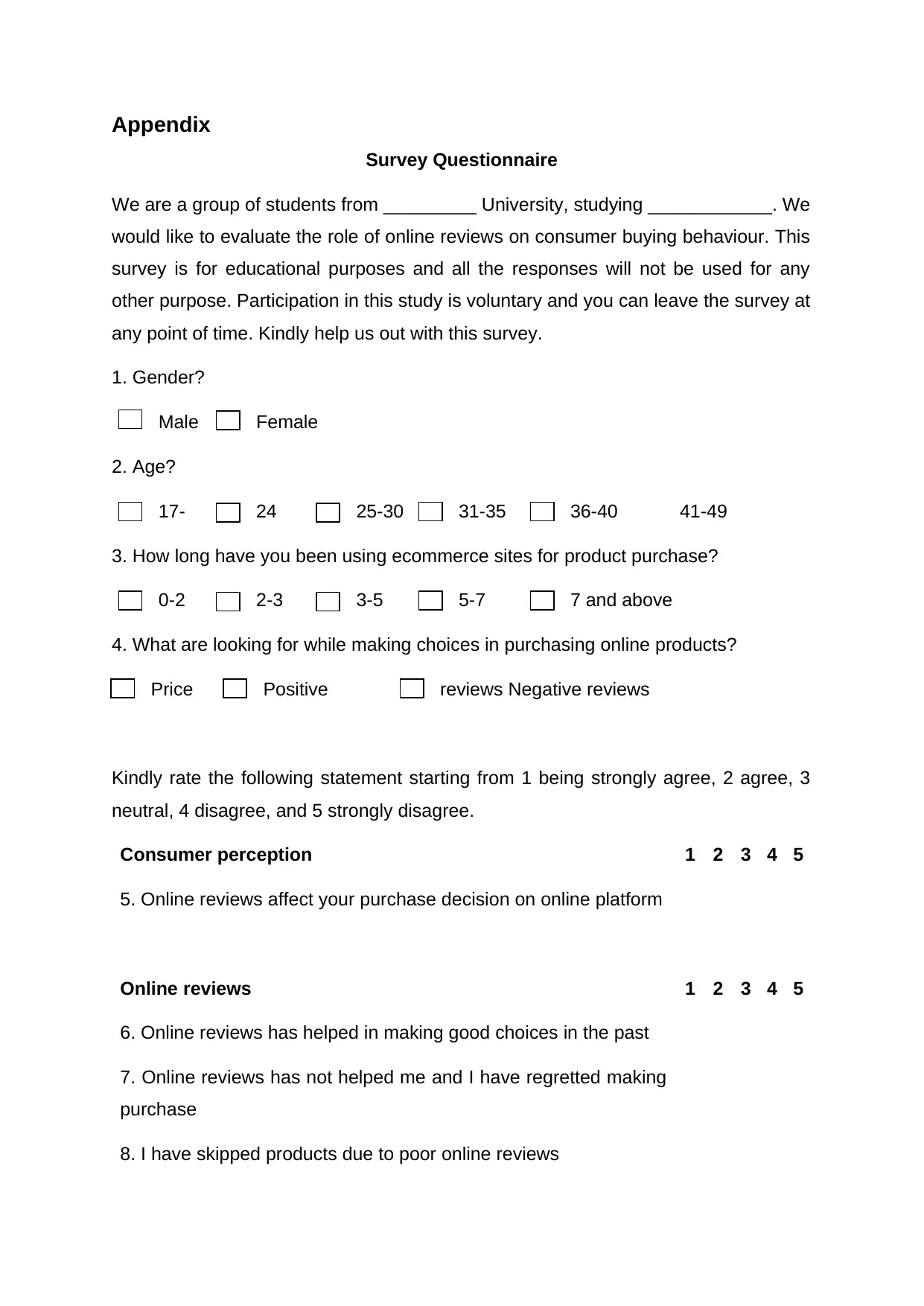
Appendix
Survey Questionnaire
We are a group of students from _________ University, studying ____________. We
would like to evaluate the role of online reviews on consumer buying behaviour. This
survey is for educational purposes and all the responses will not be used for any
other purpose. Participation in this study is voluntary and you can leave the survey at
any point of time. Kindly help us out with this survey.
1. Gender?
Male Female
2. Age?
17- 24 25-30 31-35 36-40 41-49
3. How long have you been using ecommerce sites for product purchase?
0-2 2-3 3-5 5-7 7 and above
4. What are looking for while making choices in purchasing online products?
Price Positive reviews Negative reviews
Kindly rate the following statement starting from 1 being strongly agree, 2 agree, 3
neutral, 4 disagree, and 5 strongly disagree.
Consumer perception 1 2 3 4 5
5. Online reviews affect your purchase decision on online platform
Online reviews 1 2 3 4 5
6. Online reviews has helped in making good choices in the past
7. Online reviews has not helped me and I have regretted making
purchase
8. I have skipped products due to poor online reviews
Survey Questionnaire
We are a group of students from _________ University, studying ____________. We
would like to evaluate the role of online reviews on consumer buying behaviour. This
survey is for educational purposes and all the responses will not be used for any
other purpose. Participation in this study is voluntary and you can leave the survey at
any point of time. Kindly help us out with this survey.
1. Gender?
Male Female
2. Age?
17- 24 25-30 31-35 36-40 41-49
3. How long have you been using ecommerce sites for product purchase?
0-2 2-3 3-5 5-7 7 and above
4. What are looking for while making choices in purchasing online products?
Price Positive reviews Negative reviews
Kindly rate the following statement starting from 1 being strongly agree, 2 agree, 3
neutral, 4 disagree, and 5 strongly disagree.
Consumer perception 1 2 3 4 5
5. Online reviews affect your purchase decision on online platform
Online reviews 1 2 3 4 5
6. Online reviews has helped in making good choices in the past
7. Online reviews has not helped me and I have regretted making
purchase
8. I have skipped products due to poor online reviews
⊘ This is a preview!⊘
Do you want full access?
Subscribe today to unlock all pages.

Trusted by 1+ million students worldwide
1 out of 15
Related Documents
Your All-in-One AI-Powered Toolkit for Academic Success.
+13062052269
info@desklib.com
Available 24*7 on WhatsApp / Email
![[object Object]](/_next/static/media/star-bottom.7253800d.svg)
Unlock your academic potential
Copyright © 2020–2025 A2Z Services. All Rights Reserved. Developed and managed by ZUCOL.




